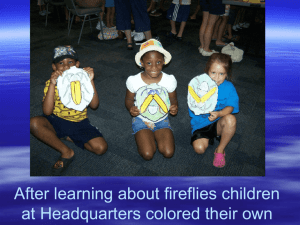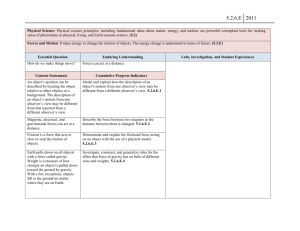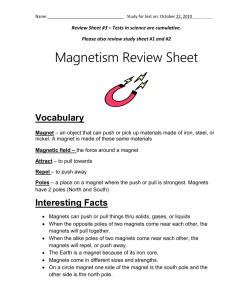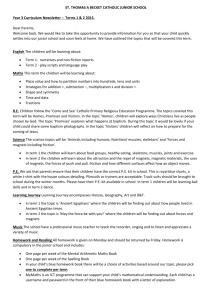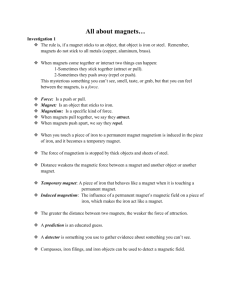Intro into Magnets
advertisement
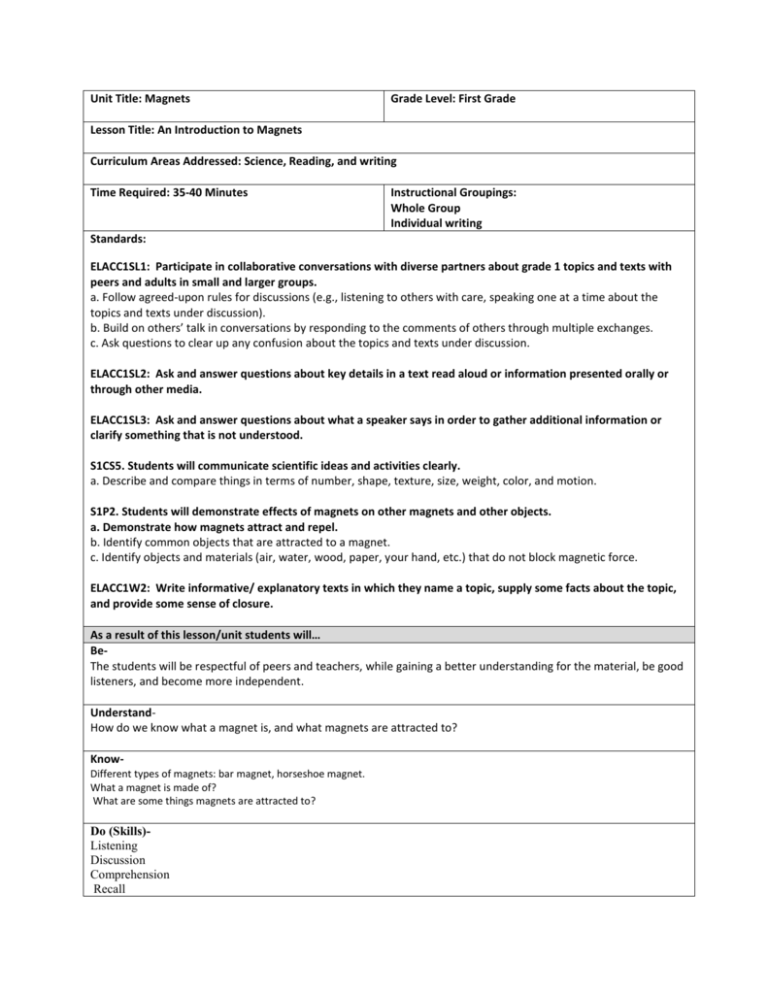
Unit Title: Magnets Grade Level: First Grade Lesson Title: An Introduction to Magnets Curriculum Areas Addressed: Science, Reading, and writing Time Required: 35-40 Minutes Instructional Groupings: Whole Group Individual writing Standards: ELACC1SL1: Participate in collaborative conversations with diverse partners about grade 1 topics and texts with peers and adults in small and larger groups. a. Follow agreed-upon rules for discussions (e.g., listening to others with care, speaking one at a time about the topics and texts under discussion). b. Build on others’ talk in conversations by responding to the comments of others through multiple exchanges. c. Ask questions to clear up any confusion about the topics and texts under discussion. ELACC1SL2: Ask and answer questions about key details in a text read aloud or information presented orally or through other media. ELACC1SL3: Ask and answer questions about what a speaker says in order to gather additional information or clarify something that is not understood. S1CS5. Students will communicate scientific ideas and activities clearly. a. Describe and compare things in terms of number, shape, texture, size, weight, color, and motion. S1P2. Students will demonstrate effects of magnets on other magnets and other objects. a. Demonstrate how magnets attract and repel. b. Identify common objects that are attracted to a magnet. c. Identify objects and materials (air, water, wood, paper, your hand, etc.) that do not block magnetic force. ELACC1W2: Write informative/ explanatory texts in which they name a topic, supply some facts about the topic, and provide some sense of closure. As a result of this lesson/unit students will… BeThe students will be respectful of peers and teachers, while gaining a better understanding for the material, be good listeners, and become more independent. UnderstandHow do we know what a magnet is, and what magnets are attracted to? KnowDifferent types of magnets: bar magnet, horseshoe magnet. What a magnet is made of? What are some things magnets are attracted to? Do (Skills)Listening Discussion Comprehension Recall Predicting Steps in the Lesson: Include the attention getter or the hook for the lesson, the introduction, the lesson procedures including ideas for whole‐class, small group, and individual instructions; differentiated activities Attention Getter or Hook: In a “tribes” circle the students will pass around two different types of magnets with an object that is attracted to them. They will get to touch and manipulate the objects. Ask them to be thinking about why the objects may be sticking to the magnet and other probing questions for misconceptions and prior knowledge. Have them think of questions they may have for after story. Introduction: Have the students stand up while in circle and move to their learning square. Read: Magnets Pulling Together, Pushing Apart by: Natalie Rosinsky. Talk about the different parts of a book (title page, table of contents, and glossary). Body or Procedures: Give students additional time to think about questions they may have about magnets from out text. Discuss the book. Ask: What did you notice about the magnets when you observed them? Did anything surprise you about how they looked or the things that they can do? What are some things that you already know about magnets? Do any of these words seem familiar to you? What makes something magnetic (or able to attract to a magnet)? What are some items that you think might attract to a magnet? What are the names of the ends of each magnet? Allow time for students to ask questions and make connections from what they observed with the magnets before the reading, and the text. Make an Anchor Chart for the different types of magnets and other important facts we learned from the text. Introduce Vocabulary on the “Science Wall”: Repel, Attract, Bar Magnet, Horseshoe Magnet, items that are magnetic, and items that are not magnetic. Closure/Wrap up: Review and compare the anchor chart and the Science Wall to see if there is anything else the students would like to add. If there is additional time, have the students draw/ write something they observed, or saw in the book while we were on the carpet. What will I differentiate? Content/Process/Product Content- Book will be easily understood for all levels, while introducing new vocabulary. While I am reading aloud to the class, they will also get to see pictures to further understanding. Process- During our discussion and question time, wait time will be used and things mentioned will be repeated multiple times. Process- Reviewing the anchor chart will help reinforce ideas for lower level students. With the drawing, I will be looking for words or sentences, pictures, coloring, and labels depending on each student. Product- For the writing piece, paper will be different for each student depending on level How will I differentiate? Wait time, questions asked over book and anchor chart Science Wall magnet key words will act as a visual to will help Visual Learners Book and anchor chart for Verbal/Linguistic, auditory, and visual Learners. For the writing piece: Lower level—look more at picture and meaning of what they wrote, less grammar structure Higher level—look for labels, detailed picture, meaningful sentence, with correct grammar How will I differentiate for featured student 1? (L.H.) I will provide her with multiple visuals: anchor chart, pictures in the book, and Science word wall Use wait time while asking her questions, prompting/scaffolding when needed Restate things in multiple ways for complete understanding since she is not a verbal learner For writing, check letter formation and case. Have her read her sentence(s) to me. How will I differentiate for featured student 2? (T.H.) While writing on the anchor chart, make sure I am facing the students so they can fully me Saying things more than once (on the word wall and anchor chart) will reinforce ideas While writing, look at work to check letter formation, ask to label items. Have him use lined paper without the dashed line Assessment: Discussion while on the carpet about our book, word wall, and anchor chart Writing piece looking at grammar and content Materials, Additional Resources, and Background Information: Variety of magnets Objects that will stick to magnets Book- Magnets Pulling Together, Pushing Apart Word wall pictures and words Chart paper, markers Writing paper Clear Links to Theories: Gardner- use of multiple intelligences Vygotsky- Student will be able to enhance their ZPD through discussion of new vocabulary, scaffolding questions, and communication skills. Piaget- Students will use prior knowledge of magnets to form new ideas and further understanding on the topic. Montessori- Students are using hands on learning by being able to manipulate magnets themselves furthering knowledge from what they are experiencing. Connections to Technology and/or the Arts: Students will draw a picture during writing time based on something they learned from our lesson Description of Collaboration with Others: Host Teacher collaboration

